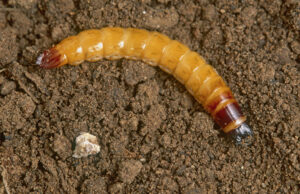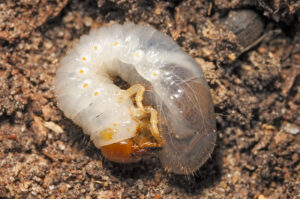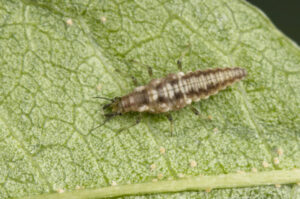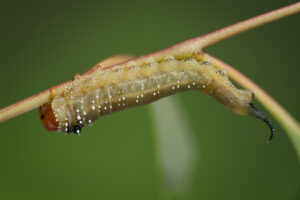
What grub is that?
By Denis Crawford
Insects that have life cycles of complete metamorphosis have larvae that come in a variety of forms.
A life cycle of complete metamorphosis (holometabolous) means hatching from an egg into a larval stage, then pupating, and later emerging as an adult. The larval stage can be one of several forms, depending on the species involved. The most recognisable form is the caterpillar – a great favourite of children, and a character in several stories e.g. The Hungry Caterpillar and Alice’s Adventures in Wonderland. Caterpillars are the larvae of moths and butterflies of the insect order Lepidoptera.

Caterpillars typically have a distinctive head, chewing mouthparts, a soft cylindrical body, three pairs of true legs, and up to five pairs of abdominal prolegs. Most caterpillars are plant feeders: either chewing leaves and bark, tunnelling into branches, or feeding underground on plant roots. There are also some predatory caterpillars: a few that feed on scale insects, several others that feed on ant larvae in ant nests, and a couple that feed on wasp larvae.
There are many other insects, not from the order Lepidoptera, that have larvae that look a bit like caterpillars. These larvae are technically known as eruciform larvae, and they have the typical head, thoracic legs, and soft cylindrical bodies of caterpillars. Sawfly larvae are obvious examples, but there are many others including the larvae of leaf-eating beetles (Chrysomelidae), longicorn beetle larvae (Cerambycidae), and weevil larvae (Curculionidae). From a horticultural point of view, what these caterpillar-like insects have in common is they are nearly always plant feeders.
Another larval form that is instantly recognisable is that of the c-shaped scarab beetle larvae – technically known as scarabaeiform. They have prominent heads with chewing mouthparts, and are pale, curled ‘grubs’ typically found underground. Most of them feed on plant roots: obvious examples are African black beetle (Heteronychus arator) and the various grubs known as ‘cockchafers’.

But not all scarab beetle larvae found underground are pests! Don’t forget the dung beetles. There are about 500 species of native dung beetles, and 30 or so introduced species of dung beetles in Australia, that provide a vital ecological service by burying animal droppings. It is difficult to tell whether a scarab beetle larva is a dung beetle larva or a cockchafer just by looking at it – you would need to see the adult form to be sure. A better way to tell what it is, is to look at where it is: amongst plant roots (cockchafer) or in a tunnel with dung (dung beetle).
The next group of insect larvae are known as campodeiform: they typically have forward-pointing heads, and their bodies are generally elongated and flattened, with well-developed legs. They are active insects, and they are usually predators of other insects. Ladybird beetle larvae and some lacewing larvae are classic examples. If you want to take just one thing from this article, this is it: ladybird larvae and lacewing larvae are often mistaken as pests. If everyone learned the difference between caterpillar-like larvae (eruciform) and these larvae, you would never mistake them for pests again. Other examples of campodeiform larvae are rove beetle larvae (Staphylinidae) and carabid beetle larvae (Carabidae), all of which are important predators.

Insect larvae such as wireworms and mealworms are known as elateriform. They are typically elongated, slender and cylindrical in shape, with toughened skins and three pairs of thoracic legs. Wireworms are the larvae of beetles commonly known as click beetles of the family Elateridae (‘true wireworms’) and beetles of the family Tenebrionidae (‘false wireworms’). They are agricultural and horticultural pests, well-known for damaging plant roots.
The final group are those described as vermiform. These are worm-like larvae with no distinctive head and no legs. Fly larvae such as those of bush flies, blow flies and house flies are classic examples. Other insects such as parasitic wasps also have larvae that are vermiform. I make special mention here of robber fly larvae (Asilidae) that are commonly found while digging in gardens. Adult robber flies are well-known predators of other insects, but so are their larvae. Large underground maggots sound like pests but aren’t necessarily. Knowing what they look like can prevent robber fly larvae inadvertently being treated as pests.

These descriptive terms I have used here (such as ‘eruciform’) can be useful in sorting insects into groups that might need to be managed, or those that can safely be left alone. Monitoring crops is a vital component of pest management, especially IPM, but you can’t monitor a crop if you don’t know what to look for.
There are hundreds of different insect species that can be found in horticultural crops, gardens, and nurseries but only a handful are pests that may require management. Most insects found will be benign (neither pest nor beneficial), or transient (passing through), or beneficial (predators or parasites of pests). Knowing the difference is rather important.
Main photo: Wireworms have a distinctive form
